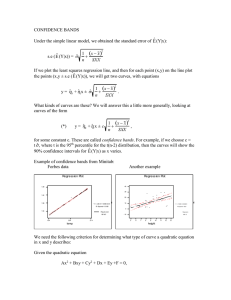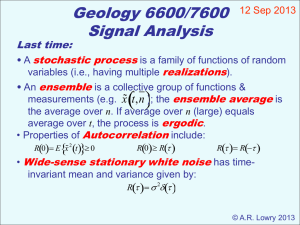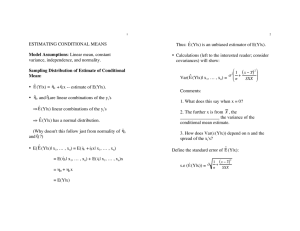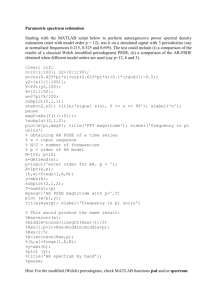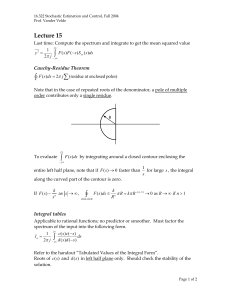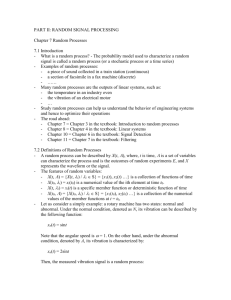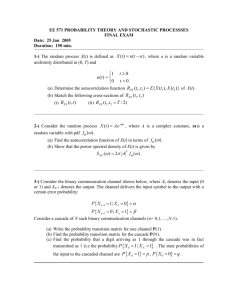hw7
advertisement
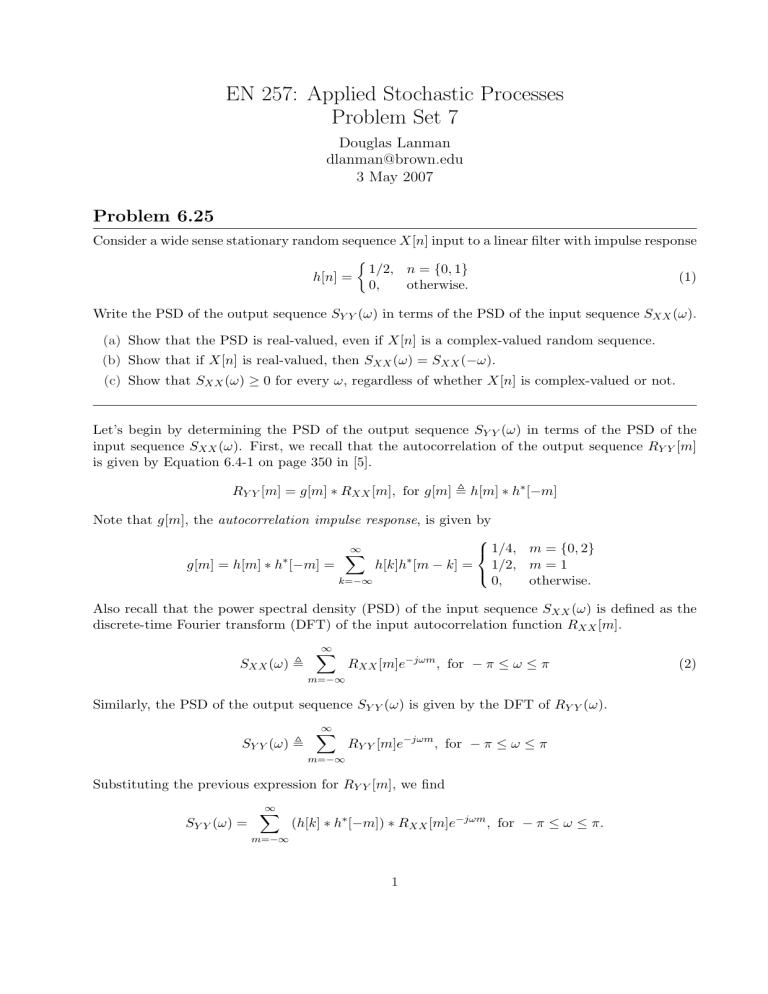
EN 257: Applied Stochastic Processes
Problem Set 7
Douglas Lanman
dlanman@brown.edu
3 May 2007
Problem 6.25
Consider a wide sense stationary random sequence X[n] input to a linear filter with impulse response
½
1/2, n = {0, 1}
h[n] =
(1)
0,
otherwise.
Write the PSD of the output sequence SY Y (ω) in terms of the PSD of the input sequence SXX (ω).
(a) Show that the PSD is real-valued, even if X[n] is a complex-valued random sequence.
(b) Show that if X[n] is real-valued, then SXX (ω) = SXX (−ω).
(c) Show that SXX (ω) ≥ 0 for every ω, regardless of whether X[n] is complex-valued or not.
Let’s begin by determining the PSD of the output sequence SY Y (ω) in terms of the PSD of the
input sequence SXX (ω). First, we recall that the autocorrelation of the output sequence RY Y [m]
is given by Equation 6.4-1 on page 350 in [5].
RY Y [m] = g[m] ∗ RXX [m], for g[m] , h[m] ∗ h∗ [−m]
Note that g[m], the autocorrelation impulse response, is given by
∞
1/4, m = {0, 2}
X
h[k]h∗ [m − k] = 1/2, m = 1
g[m] = h[m] ∗ h∗ [−m] =
k=−∞
0,
otherwise.
Also recall that the power spectral density (PSD) of the input sequence SXX (ω) is defined as the
discrete-time Fourier transform (DFT) of the input autocorrelation function RXX [m].
SXX (ω) ,
∞
X
RXX [m]e−jωm , for − π ≤ ω ≤ π
m=−∞
Similarly, the PSD of the output sequence SY Y (ω) is given by the DFT of RY Y (ω).
SY Y (ω) ,
∞
X
RY Y [m]e−jωm , for − π ≤ ω ≤ π
m=−∞
Substituting the previous expression for RY Y [m], we find
SY Y (ω) =
∞
X
(h[k] ∗ h∗ [−m]) ∗ RXX [m]e−jωm , for − π ≤ ω ≤ π.
m=−∞
1
(2)
EN 257: Applied Stochastic Processes
Problem Set 7
Douglas Lanman
From the derivation of Equation 6.4-2b on page 351, we conclude that the general form of the
output PSD is given by the following expression.
SY Y (ω) = |H(ω)|2 SXX (ω), for − π ≤ ω ≤ π
(3)
At this point we can evaluate the DFT of the impulse response, as defined in Equation 1.
H(ω) =
∞
X
h[m]e−jωm =
m=−∞
¢
1¡
1 − e−jω
2
The magnitude of H(ω) is then given by
|H(ω)|2 =
¢¡
¢
1¡
1 − e−jω 1 − ejω = cos2 (ω/2) .
4
Substituting this result in Equation 3 gives the desired expression for the PSD of the output.
SY Y (ω) = cos2 (ω/2) SXX (ω), for − π ≤ ω ≤ π
Part (a)
To prove that the PSD SXX (ω) is a real-valued function, we begin by proving that the autocorre∗ [−m]. From the definition of the
lation function is conjugate symmetric, such that RXX [m] = RXX
autocorrelation function RXX [m], we have
∗
RXX [m] = E{X[k + m]X ∗ [k]} = E{X[k]X ∗ [k − m]} = E ∗ {X[k − m]X ∗ [k]} = RXX
[−m].
(4)
If SXX (ω) is real-valued, then it must satisfy the following condition.
∗
SXX (ω) = SXX
(ω)
Substituting Equation 2, we must show that the following equality holds.
à ∞
!∗
∞
X
X
RXX [m]e−jωm =
RXX [m]e−jωm
m=−∞
m=−∞
∞
X
∗
RXX
[m]ejωm
=
=
=
m=−∞
∞
X
m=−∞
∞
X
RXX [−m]ejωm
RXX [m]e−jωm
m=−∞
Note that in the previous expression we have applied the result of Equation 4 to conclude that
∗ [m] = R
RXX
XX [−m]. In addition, we have substituted −m for m since the order of summation
can be reversed. In conclusion, since the left-hand and right-hand sides of the previous expression
are equal, we find that SXX (ω) is a real-valued function, even if X[n] is a complex-valued sequence.
∗
∴ SXX (ω) = SXX
(ω) ⇒ SXX (ω) ∈ R, for − π ≤ ω ≤ π
2
EN 257: Applied Stochastic Processes
Problem Set 7
Douglas Lanman
Part (b)
Let’s begin by using Equation 2 to express SXX (−ω).
SXX (−ω) =
∞
X
RXX [m]ejωm =
m=−∞
∞
X
RXX [−m]e−jωm
m=−∞
Note that, since the order of summation can be reversed, we have substituted −m for m in the
right-hand expression. At this point we can apply the result of Equation 4 to conclude RXX [−m] =
∗ [m]. Now recall that the autocorrelation function R
RXX
XX [m] will be real-valued if X[n] is realvalued, such that
∗
RXX
[m] = E ∗ {X[k + m]X ∗ [k]} = E{X[k + m]X[k]} = RXX [m], for {X[n]} ∈ R.
We conclude that RXX [−m] = RXX [m] if X[n] is real-valued and, substituting into the previous
expression, we find that SXX (ω) is an even function if X[n] is real-valued.
∴ SXX (ω) = SXX (−ω), for {X[n]} ∈ R
Part (c)
Recall, from page 351 in [5], that the inverse Fourier transform of the PSD SXX (ω) is equal to the
autocorrelation function RXX [m].
Z π
1
SXX (ω)ejωm dω
RXX [m] =
2π −π
Applying Equation 3, we find that the output autocorrelation function is given by
Z π
1
|H(ω)|2 SXX (ω)ejωm dω.
RY Y [m] =
2π −π
At this point, consider a narrowband low-pass filter H(ω), with bandwidth 2², centered at frequency
ωo , where |ω0 | < π, and with unity gain in the passband. Substituting into the previous expression
and evaluating at m = 0, we find
Z ωo +²
1
²
RY Y [0] =
SXX (ω)dω ' SXX (ωo ), for − π ≤ ωo ≤ π.
2π ωo −²
π
At this point we recall that RY Y [0] is a non-negative function, since
RY Y [0] = E{Y [k]Y ∗ [k]} = E{|Y [k]|2 } ≥ 0.
Substituting this result into the previous expression, we find that SXX (ω) ≥ 0 for every ω, regardless
of whether X[n] is complex-valued or not.
∴ SXX (ω) ≥ 0, for − π ≤ ω ≤ π
3
EN 257: Applied Stochastic Processes
Problem Set 7
Douglas Lanman
Problem 6.26
Let the WSS random sequence X have the correlation function
RXX [m] = 10e−λ1 |m| + 5e−λ2 |m|
with λ1 > 0 and λ2 > 0. Find the corresponding PSD SXX (ω) for |ω| ≤ π.
Substituting into Equation 2, we find that the PSD SXX (ω) is given by the following expression.
∞
X
SXX (ω) =
=
RXX [m]e−jωm
m=−∞
∞
³
X
10e
−λ1 |m|
+ 5e
−λ2 |m|
m=−∞
Ã
=
∞
X
10
´
!
e−λ1 |m| e−jωm
e−jωm
Ã
+
m=−∞
!
∞
X
5
e−λ2 |m| e−jωm
m=−∞
As an aside, we note that the first term in the previous expression can be further simplified by
separating the summation into several components.
10
∞
X
e−λ1 |m| e−jωm = 10 + 10
m=−∞
= 10 + 10
= 10 + 10
= 10 + 20
−1
X
m=−∞
∞
X
−λ1 |m| jωm
e
m=1
∞
X
m=1
∞
X
∞
X
e−λ1 |m| e−jωm + 10
e
e−λ1 |m| e−jωm
m=1
+ 10
∞
X
e−λ1 |m| e−jωm
m=1
¡
¢
e−λ1 |m| ejωm + e−jωm
e−λ1 m cos(ωm)
m=1
Substituting this result into the previous expression yields the following solution for the PSD
SXX (ω) for ω ≤ π.
SXX (ω) = 15 +
∞ ³
X
´
20e−λ1 m + 10e−λ2 m cos(ωm), for |ω| ≤ π
m=1
Applying additional trigonometric identities, we find that this expression can be further simplified.
SXX (ω) =
10 sinh(λ1 )
5 sinh(λ2 )
+
, for |ω| ≤ π
cosh(λ1 ) − cos(ω) cosh(λ2 ) − cos(ω)
4
EN 257: Applied Stochastic Processes
Problem Set 7
Douglas Lanman
Problem 6.29
Consider the LTI system show in Figure P6.29 on page 395 in [5]. Let X[n] and V [n] be WSS and
mutually uncorrelated with zero-mean and PSD’s SXX (ω) and SV V (ω), respectively.
(a) Find the PSD of the output SY Y (ω).
(b) Find the cross-power spectral density SXY (ω) between the input X and output Y .
Part (a)
Recall from Equation 2 that the PSD of the input sequence SXX (ω) is defined as the discrete-time
Fourier transform (DFT) of the input autocorrelation function RXX [m].
SXX (ω) ,
∞
X
RXX [m]e−jωm , for − π ≤ ω ≤ π
m=−∞
Similarly, the PSD of the output sequence SY Y (ω) is given by the DFT of RY Y (ω).
SY Y (ω) ,
∞
X
RY Y [m]e−jωm , for − π ≤ ω ≤ π
m=−∞
In order to proceed, we must first find an expression for RY Y [m] in terms of RXX [m] and RV V [m].
Let us define
Z[n] , X[n] + V [n]
as the input to the LTI system with impulse response h[n]. By the definition of the autocorrelation
function, we must have the following condition (see Table 7.5-1 on page 444 in [5]).
RZZ [m] = E{Z[k + m]Z ∗ [k]}
= E{(X[k + m] + V [k + m])(X[k] + V [k])∗ }
= E{X[k + m]X ∗ [k]} + E{X[k + m]V ∗ [k]} + E{V [k + m]X ∗ [k]} + E{V [k + m]V ∗ [k]}
= E{X[k + m]X ∗ [k]} + E{V [k + m]V ∗ [k]}
= RXX [m] + RV V [m]
(5)
Note that, since X[n] and V [n] are mutually uncorrelated, we can conclude that E{X[k+m]V ∗ [k]} =
E{V [k + m]X ∗ [k]} = 0. Now recall the expression for SY Y previously derived in Problem 6.25.
SY Y (ω) =
∞
X
(h[k] ∗ h∗ [−m]) ∗ RZZ [m]e−jωm , for − π ≤ ω ≤ π
m=−∞
Substituting Equation 5, we find that
SY Y (ω) =
∞
X
(h[k] ∗ h∗ [−m]) ∗ RXX [m]e−jωm +
m=−∞
∞
X
(h[k] ∗ h∗ [−m]) ∗ RV V [m]e−jωm .
m=−∞
Finally, we recall the following properties of the DFT: (1) the DFT of the convolution of two
functions is the product of their discrete-time Fourier transforms, and (2) the DFT of the complex
5
EN 257: Applied Stochastic Processes
Problem Set 7
Douglas Lanman
conjugate of a time-reversed function is equal to the complex conjugate of the Fourier transform
of the original function [3]. In addition, we remember from Equation 2 that the autocorrelation
function and the power spectral density are Fourier transform pairs. Applying these conditions to
the previous expression gives the following result for the PSD of the output SY Y (ω).
SY Y (ω) = |H(ω)|2 SXX (ω) + |H(ω)|2 SV V (ω), for − π ≤ ω ≤ π
Part (b)
Similar to the previous part, we begin by recalling the definition of the cross-power spectral density
SXY (ω) given on page 352 in [5].
∞
X
SXY (ω) ,
RXY [m]e−jωm , for − π ≤ ω ≤ π
(6)
m=−∞
In order to evaluate SXY (ω), we require a closed-form expression for the cross-correlation function
RXY (ω). Following the derivation on page 349, we find the following result.
RXY [m, n] = E{X[m]Y ∗ [n]}
∞
X
=
h∗ [n − k]E{X[m]Z ∗ [k]}
=
=
=
=
k=−∞
∞
X
k=−∞
∞
X
k=−∞
∞
X
k=−∞
∞
X
h∗ [n − k]E{X[m](X ∗ [k] + V ∗ [k])}
h∗ [n − k]E{X[m]X ∗ [k]} +
∞
X
h∗ [n − k]E{X[m]V ∗ [k]}
k=−∞
h∗ [n − k]RXX [m − k]
h∗ [−l]RXX [(m − n) − l], for l , k − n
k=−∞
At this point we note that the cross-correlation RXY [m, n] is shift-invariant. As a result, we can
define RXY [m] , RXY [m, 0]. Substituting this result into the previous expression yields
RXY [m] =
∞
X
h∗ [−l]RXX [m − l] = h∗ [−m] ∗ RXX [m].
k=−∞
Now we can evaluate Equation 6 to find the desired expression for the cross-power spectral density.
SXY (ω) =
∞
X
h∗ [−m] ∗ RXX [m]e−jωm , for − π ≤ ω ≤ π
m=−∞
Applying the previous properties of the DFT used in Part (a), we conclude that SXY (ω) is given
by the following expression.
SXY (ω) = H ∗ (ω)SXX (ω), for − π ≤ ω ≤ π
6
EN 257: Applied Stochastic Processes
Problem Set 7
Douglas Lanman
Problem 6.32
Recall that a Markov random sequence X[n] is specified by its first-order pdf fX (x; n) and its
one-step conditional pdf
fX (xn |xn−1 ; n, n − 1) = fX (xn |xn−1 ).
(a) Find the two-step pdf fX (xn |xn−2 ) for a Markov random sequence in terms of the above
functions. For this problem, take n ≥ 2 for a sequence starting at n = 0.
(b) Find the N-step pdf fX (xn |xn−N ) for an arbitrary positive integer N , where n ≥ N .
Part (a)
Recall from pages 429-430 in [5] that the Chapman-Kolmogorov equations can be used to compute
the conditional density of X[n3 ] given X[n1 ], for n3 > n2 > n1 . To begin our analysis, we note
that the joint pdf can be written as follows.
Z ∞
fX (x3 , x1 ; n3 , n1 ) =
fX (x3 |x2 , x1 ; n3 , n2 , n1 )fX (x2 , x1 ; n2 , n1 )dx2
−∞
Dividing both sides of this expression by f (x1 ; n1 ) yields the following result.
Z ∞
fX (x3 |x1 ; n3 , n1 ) =
fX (x3 |x2 , x1 ; n3 , n2 , n1 )fX (x2 |x1 ; n2 , n1 )dx2
−∞
Finally, by applying the Markov property we arrive at the well-known Chapman-Kolmogorov equation for the transition density fX (x3 |x1 ).
Z ∞
fX (x3 |x1 ; n3 , n1 ) =
fX (x3 |x2 ; n3 , n2 )fX (x2 |x1 ; n2 , n1 )dx2 , for n3 > n2 > n1
(7)
−∞
From this condition we can conclude that the two-step pdf fX (xn |xn−2 ) for a Markov random
sequence is given by the following expression (using the simplified notation in the original problem
statement).
Z ∞
fX (xn |xn−2 ) =
fX (xn |xn−1 )fX (xn−1 |xn−2 )dxn−1
−∞
Part (b)
The N-step pdf fX (xn |xn−N ), for an arbitrary positive integer N , can be found in a similar manner
as the previous problem by repeatedly using conditioning (i.e., the chain rule of probability [5]).
Z
fX (xn |xn−N ) =
Z
∞
∞
...
−∞
−∞
fX (xn |xn−1 )fX (xn−1 |xn−2 ) . . . fX (xn−N +1 |xn−N )dxn−1 dxn−2 . . . dxn−N +1
7
EN 257: Applied Stochastic Processes
Problem Set 7
Douglas Lanman
Problem 6.33
Consider a Markov random sequence X[n] on 1 ≤ n ≤ N that is statistically described by its
first-order pdf fX (x; 1) and its one-step transition (conditional) pdf fX (xn |xn−1 ; n, n − 1). By the
Markov definition and suppressing time variables, we have
fX (xn |xn−1 ) = fX (xn |xn−1 , xn−2 , . . . , x1 ) for 2 ≤ n ≤ N.
Show that such a Markov sequence is also Markov in the reverse order, such that
fX (xn |xn+1 ) = fX (xn |xn+1 , xn+2 , . . . , xN ) for 1 ≤ n ≤ N − 1
and, as a result, one can alternatively describe a Markov random sequence by its one-step backward
pdf fX (xn−1 |xn ; n − 1, n) and its first-order pdf fX (x; N ).
Recall, from Equation 2.6-52 on page 104 in [5], that the following expression relates the conditional
pdfs for two random variables X and Y .
fX|Y (x|y) =
fY |X (y|x)fX (x)
fY (y)
(8)
Furthermore, we recall that the chain rule of probability and the Markov property can be used to
express the joint pdf as follows.
fX (x1 , x2 , . . . , xN −1 , xN ) = fX (xN |xN −1 )fX (xN −1 |xN −2 ) . . . fX (x2 |x1 )fX (x1 )
From Equation 8 we observe that the following condition can be used to relate the conditional
probability density functions.
fX (xn |xn−1 ) =
fX (xn−1 |xn )fX (xn )
fX (xn−1 )
Substituting this result into the previous expression yields the following equation.
fX (x1 , x2 , . . . , xN −1 , xN ) =
µ
¶µ
¶ µ
¶
fX (xN −1 |xN )fX (xN )
fX (xN −2 |xN −1 )fX (xN −1 )
fX (x1 |x2 )fX (x2 )
...
fX (x1 )
fX (xN −1 )
fX (xN −2 )
fX (x1 )
Simplifying this expression yields the following result.
fX (x1 , x2 , . . . , xN −1 , xN ) = fX (x1 |x2 )fX (x2 |x3 ) . . . fX (xN −1 |xN )fX (xN )
Note that this expression has the general form of a Markov sequence in reverse order. As a result,
we conclude that a Markov sequence is also Markov in the reverse order, such that
fX (xn |xn+1 ) = fX (xn |xn+1 , xn+2 , . . . , xN ) for 1 ≤ n ≤ N − 1
and, as a result, one can alternatively describe a Markov random sequence by its one-step backward
pdf fX (xn−1 |xn ; n − 1, n) and its first-order pdf fX (x; N ).
8
EN 257: Applied Stochastic Processes
Problem Set 7
Douglas Lanman
Problem 6.34
Let X[n] be a Markov chain on n ≥ 1 with transition probabilities given by P (x[n]|x[n − 1]).
(a) Find an expression for the two-step transition probabilities P (x[n]|x[n − 2]).
(b) Show that P (x[n + 1]|x[n − 1], x[n − 2], . . . , x[1]) = P (x[n + 1]|x[n − 1]), for n ≥ 1.
Part (a)
Similar to Problem 6.32 we can apply the Chapman-Kolmogorov equations to compute the conditional probability of X[n3 ] given X[n1 ], for n3 > n2 > n1 . To begin our analysis, we note that the
joint probability can be written as
X
P (x[n3 ], x[n1 ]) =
P (x[n3 ]|x[n2 ], x[n1 ])P (x[n2 ], x[n1 ]),
x[n2 ]∈X2
where X2 denotes all possible values of the discrete random variable X[n2 ]. Dividing both sides of
this expression by P (x[n1 ]) yields the following result.
X
P (x[n3 ]|x[n1 ]) =
P (x[n3 ]|x[n2 ], x[n1 ])P (x[n2 ]|x[n1 ])
x[n2 ]∈X2
Finally, by applying the Markov property we arrive at the well-known Chapman-Kolmogorov equation for the transition probability P (x[n3 ]|x[n1 ]).
X
P (x[n3 ]|x[n1 ]) =
P (x[n3 ]|x[n2 ])P (x[n2 ]|x[n1 ])
x[n2 ]∈X2
From this condition we conclude that the two-step transition probabilities P (x[n]|x[n−2]) are given
by the following expression.
P (x[n]|x[n − 2]) =
X
P (x[n]|x[n − 1])P (x[n − 1]|x[n − 2])
x[n−1]∈Xn−1
Part (b)
From the previous derivation we conclude that the following condition must hold for n ≥ 1.
X
P (x[n + 1]|x[n − 1], . . . , x[1]) =
P (x[n + 1]|x[n], . . . , x[1])P (x[n]|x[n − 1], . . . , x[1])
x[n]∈Xn
By the Markov property this expression has the following simplified form.
X
P (x[n + 1]|x[n − 1], . . . , x[1]) =
P (x[n + 1]|x[n])P (x[n]|x[n − 1])
x[n]∈Xn
By inspection, we conclude that this result is identical to that found in Part (a). As a result, we
conclude that the desired relationship holds.
P (x[n + 1]|x[n − 1], x[n − 2], . . . , x[1]) = P (x[n + 1]|x[n − 1]), for n ≥ 1
9
EN 257: Applied Stochastic Processes
Problem Set 7
Douglas Lanman
Problem 7.40
Express the answers to the following questions in terms of probability density functions.
(a) State the definition of an independent-increments random process.
(b) State the definition of a Markov random process.
(c) Prove that any random process that has independent increments also has the Markov property.
Part (a)
Recall, from pages 326 and 410 in [5], that a random process has independent increments when the
set of n random variables
X(t1 ), X(t2 ) − X(t1 ), . . . , X(tn ) − X(tn−1 )
are jointly independent for all t1 < t2 < . . . < tn and n ≥ 1. In terms of probability density
functions, we note that a random process X(t) with independent increments must satisfy
fX (xn − xn−1 |xn−1 , xn−2 , . . . , x1 ; tn , tn−1 , . . . , t1 ) = fX (xn − xn−1 ; tn , tn−1 ),
(9)
for all x1 , x2 , . . . , xn and integers n > 0 where t1 < t2 < . . . < tn .
Part (b)
From page 422 in [5] we recall that a (first-order) continuous-valued Markov process X(t) satisfies
fX (xn |xn−1 , xn−2 , . . . , x1 ; tn , tn−1 , . . . , t1 ) = fX (xn |xn−1 ; tn , tn−1 ),
(10)
for all x1 , x2 , . . . , xn and integers n > 0 where t1 < t2 < . . . < tn . Note that this expression
defines the so-called one-step conditional pdf, however a continuous-valued Markov process must
also satisfy the following k-step pdf given by
fX (xn+k |xn , xn−1 , . . . , x1 ; tn+k , tn , tn−1 , . . . , t1 ) = fX (xn+k |xn ; tn+k , tn ),
for all x1 , x2 , . . . , xn , xn+k and integers n > 0 and k > 0 where t1 < t2 < . . . < tn < tn+k .
Part (c)
Following the derivation outlined on page 423 in [5], we note that any random process X(t) with
independent increments must have a pdf that can be expressed in the following form.
fX (xn |xn−1 , xn−2 , . . . , x1 ; tn , tn−1 , . . . , t1 ) = fX (xn − xn−1 |xn−1 , xn−2 , . . . , x1 ; tn , tn−1 , . . . , t1 )
= fX (xn − xn−1 ; tn , tn−1 )
= fX (xn − xn−1 |xn−1 ; tn , tn−1 )
= fX (xn |xn−1 ; tn , tn−1 )
Note that, on the first two lines of this expression, we have applied the definition of independent
increments given by Equation 9. Since the last line is identical to the definition of Markov random processes given by Equation 10, we conclude that any random process that has independent
increments also has the Markov property.
10
EN 257: Applied Stochastic Processes
Problem Set 7
Douglas Lanman
Problem 7.46
Consider the linear system shown in Figure P7.46 on page 485 in [5], which is excited by two
orthogonal zero-mean, jointly wide-sense stationary random processes X(t), the signal, and U (t),
the noise. Let the input to the system G be
Y (t) = h(t) ∗ X(t) + U (t),
which models a distorted-signal-in-noise estimation problem. If we pass the received signal Y (t)
through the filter G, we obtain an estimate X̂(t). Finally, we define the estimation error ε(t) such
that
ε(t) = X̂(t) − X(t).
In the following problems we will evaluate some relevant power and cross-power spectral densities.
(a) Find SY Y (ω).
∗ (ω) in terms of H(ω), G(ω), S
(b) Find SX̂X (ω) = SX
XX (ω), and SU U (ω).
X̂
(c) Find Sεε (ω).
(d) Show that, in order to minimize Sεε (ω) at frequencies where SXX (ω) >> SU U (ω), we should
select G ≈ H −1 . Similarly, where SXX (ω) << SU U (ω), we should have G ≈ 0.
Part (a)
To begin our analysis we recall that the power spectral density SXX (ω), for a continuous-valued
wide-sense stationary random process X(t), is given on page 443 in [5].
Z ∞
SXX (ω) ,
RXX (τ )e−jωτ dτ
−∞
Similar to Part (a) of Problem 6.29 and as given by Equation7.5-14, we recall that a LTI system
with frequency response H(ω) has the following output PSD SY Y (ω) for the input process X(t).
Z ∞
Z ∞
−jωτ
SY Y (ω) =
RY Y (τ )e
dτ =
h(τ ) ∗ RXX (τ ) ∗ h∗ (−τ )e−jωτ dτ = |H(ω)|2 SXX (ω)
−∞
−∞
Next, we observe that h(t) ∗ X(t) and U (t) are orthogonal since
½Z ∞
¾
∗
∗
E {[h(t) ∗ X(t1 )] Y (t2 )} = E
h(τ )X(t1 − τ )Y (t2 )dτ
−∞
Z ∞
=
h(τ )E {X(t1 − τ )Y ∗ (t2 )} dτ = 0
−∞
and E {X(t1 − τ )Y ∗ (t2 )} = 0 for the orthogonal random processes X(t) and Y (t) (see page 437).
Finally, we recall from Table 7.5-1 that the PSD of two orthogonal random process X1 (t) and X2 (t)
is given by SX1 X1 (ω) + SX2 X2 (ω). In conclusion SY Y (ω) is given by the following expression.
SY Y (ω) = |H(ω)|2 SXX (ω) + SU U (ω)
11
EN 257: Applied Stochastic Processes
Problem Set 7
Douglas Lanman
Part (b)
From the problem statement, we have
X̂(t) = g(t) ∗ [h(t) ∗ X(t) + U (t)] = g(t) ∗ h(t) ∗ X(t) + g(t) ∗ U (t).
(11)
Now we recall that the cross-power spectral density SX̂X (ω) is given by the following expression.
Z ∞
SX̂X (ω) =
RX̂X (τ )e−jωτ dτ
−∞
To proceed we need to obtain a closed-form expression for the cross-correlation RX̂X (ω). By
definition, we have
n
o
RX̂X (τ ) = E X̂(t + τ )X ∗ (t)
= E {[g(t + τ ) ∗ h(t + τ ) ∗ X(t + τ ) + g(t + τ ) ∗ U (t + τ )] X ∗ (t)}
= E {[g(t + τ ) ∗ h(t + τ ) ∗ X(t + τ )] X ∗ (t)} + E {[g(t + τ ) ∗ U (t + τ )] X ∗ (t)}
= g(t + τ ) ∗ h(t + τ ) ∗ E {X(t + τ )X ∗ (t)}
= g(τ ) ∗ h(τ ) ∗ RXX (τ ),
(12)
since, by definition, X(t) and U (t) are orthogonal random processes such that RU X (t1 , t2 ) =
E {U (t1 )X ∗ (t2 )} = 0 for all t1 and t2 . Substituting Equation 12 into Equation 11 yields the
following solution for SX̂X (ω).
SX̂X (ω) = H(ω)G(ω)SXX (ω)
Part (c)
From the problem statement and Equation 11, we find
ε(t) = X̂(t) − X(t) = [g(t) ∗ h(t) − δ(t)] ∗ X(t) + g(t) ∗ U (t).
Correspondingly, the power spectral density of the estimation error is given by
Z ∞
Sεε (ω) =
Rεε (τ )e−jωτ dτ.
−∞
Since the Fourier transform of the Dirac delta function δ(t) is equal to unity, we conclude that the
power spectral density of the estimation error has the following solution.
Sεε (ω) = |G(ω)H(ω) − 1|2 SXX (ω) + |G(ω)|2 SU U (ω)
(13)
Part (d)
From Equation 13 we find that, in order to minimize Sεε (ω) for SXX (ω) >> SU U (ω), we must
select G(ω) ≈ [H(ω)]−1 . Similarly, G ≈ 0 minimizes Sεε (ω) for SXX (ω) << SU U (ω). In summary,
the following conditions on G(ω) will minimize the power spectral density of the estimation error.
¯
¯2
¯
¯
Sεε (ω) = ¯[H(ω)]−1 H(ω) − 1¯ SXX (ω) + |H(ω)|−2 SU U (ω) ≈ 0, for SXX (ω) >> SU U (ω)
Sεε (ω) = SXX (ω) ≈ 0, for SXX << SU U (ω)
12
EN 257: Applied Stochastic Processes
Problem Set 7
Douglas Lanman
Problem 7.47
Let X(t), the input to the system in Figure P7.47 on page 486 in [5], be a stationary Gaussian
random process. The power spectral density of Z(t) is measured experimentally and found to be
SZZ (ω) = πδ(ω) +
2β
.
(ω 2 + β 2 )(ω 2 + 1)
(a) Find the correlation function SY Y (ω) in terms of β.
(b) Find the correlation function SXX (ω).
Part (a)
To begin our analysis we recall that the power spectral density SZZ (ω) is given on page 443 in [5].
Z ∞
Z ∞
−jωτ
SZZ (ω) =
RZZ (τ )e
dτ =
h(τ ) ∗ RY Y (τ ) ∗ h∗ (−τ )e−jωτ dτ = |H(ω)|2 SY Y (ω)
−∞
−∞
To proceed we need to determine a closed-form expression for the system frequency response H(ω).
By definition the frequency response H(ω) is the discrete-time Fourier transform of the impulse
response h(t). As a result, we have
Z ∞
Z ∞
Z ∞
1
e−(1+jω)τ dτ =
e−τ u(τ )e−jωτ dτ =
h(τ )e−jωτ dτ =
H(ω) =
.
1
+
jω
0
−∞
−∞
Evaluating the frequency response magnitude |H(ω)|2 , we find
|H(ω)|2 = H(ω)H ∗ (ω) =
ω2
1
.
+1
Substituting into the previous expression for SZZ (ω) yields a solution for SY Y (ω) in terms of β.
SY Y (ω) =
SZZ (ω)
, for |H(ω)| 6= 0
|H(ω)|2
⇒
SY Y (ω) = π(ω 2 + 1)δ(ω) +
ω2
2β
+ β2
Part (b)
Recall from Table 7.5-1 in [5] that the power spectral density of a random process X n (t), generated
from the random process X(t), is given by ω 2n SXX (ω). As a result, we find that the PSD of X 2 (t)
should be given by ω 4 SXX (ω). Since Y (t) = X 2 (t), we conclude that the correlation function
SXX (ω) has the following form.
SY Y (ω)
, for ω 6= 0
SXX (ω) =
ω4
µ
⇒
SY Y (ω) = π
13
ω2 + 1
ω4
¶
δ(ω) +
2β
, for ω 6= 0
+ β2)
ω 4 (ω 2
EN 257: Applied Stochastic Processes
Problem Set 7
Douglas Lanman
Problem 9.3
Use the orthogonality principle to show that the minimum mean-square error (MMSE)
ε2 , E[(X − E[X|Y ])2 ],
(14)
for real-valued random variables, can be expressed as
ε2 = E[X(X − E[X|Y ])]
or as
ε2 = E[X 2 ] − E[E[X|Y ]2 ].
Generalize to the case where X and Y are real-valued random vectors. That is, show that the
MMSE matrix is
ε2 , E[(X − E[X|Y])(X − E[X|Y])T ]
(15)
= E[X(X − E[X|Y])T ]
= E[XXT ] − E[E[X|Y]E T [X|Y]].
Let’s begin by expanding the product in Equation 14.
ε2 = E[(X − E[X|Y ])(X − E[X|Y ])]
= E[X(X − E[X|Y ]) − E[X|Y ](X − E[X|Y ])]
= E[X(X − E[X|Y ])] − E[E[X|Y ](X − E[X|Y ])]
(16)
At this point we recall the orthogonality principle, as given by Property 9.1-1 on page 555 in [5]
and Theorem 5.4.1 on page 327 in [2]. That is, the MMSE error vector
ε , X − E[X|Y]
is orthogonal to any measurable function h(Y) of the data, such that
E[h∗ (Y)(X − E[X|Y])T ] = 0.
(17)
For the random variables X and Y , Equation 17 yields the following condition for h∗ (Y ) , E[X|Y ].
E[E[X|Y ](X − E[X|Y ])] = 0
Substituting this result into Equation 16 yields the desired relation via the orthogonality principle.
ε2 = E[X(X − E[X|Y ])]
To complete the scalar-valued derivation, we further expand this product as follows.
ε2 = E[X(X − E[X|Y ])] = E[X 2 ] − E[XE[X|Y ]]
Recall, from Equation 4.2-27 in [5], the smoothing property of the conditional expectation ensures
E[X] = E[E[X|Y ]]
14
EN 257: Applied Stochastic Processes
Problem Set 7
Douglas Lanman
for the random variables X and Y . Applying this condition to the previous expression yields the
final solution.
∴ ε2 = E[X(X − E[X|Y ])] = E[X 2 ] − E[E[X|Y ]2 ]
Now let’s generalize to the case where X and Y are real-valued random vectors. We begin by
expanding the product in Equation 15.
ε2 = E[(X − E[X|Y])(X − E[X|Y])T ]
= E[X(X − E[X|Y])T − E[X|Y](X − E[X|Y])T ]
= E[X(X − E[X|Y])T ] − E[E[X|Y](X − E[X|Y])T ]
(18)
For the random vectors X and Y, Equation 17 yields the following condition for h∗ (Y) , E[X|Y].
E[E[X|Y](X − E[X|Y])T ] = 0
Substituting this result into Equation 18 yields the desired relation via the orthogonality principle.
ε2 = E[X(X − E[X|Y])T ]
To complete the vector-valued derivation, we further expand this product as follows.
ε2 = E[XXT ] − E[XE T [X|Y]]
As in the scalar-valued case, the smoothing property of the conditional expectation ensures
E[X] = E[E[X|Y]].
Applying this condition to the previous expression yields the desired solution.
∴ ε2 = E[X(X − E[X|Y])T ] = E[XXT ] − E[E[X|Y]E T [X|Y]]
(QED)
15
EN 257: Applied Stochastic Processes
Problem Set 7
Douglas Lanman
Problem 9.6
A Gaussian random sequence X[n], for n = 0, 1, 2, . . ., is defined as
X[n] = −
¶
n µ
X
k+2
2
k=1
X[n − k] + W [n],
(19)
where X[0] = W [0] and W [n] is a Gaussian white noise sequence with zero mean and unity variance.
(a) Show that W [n] is the innovations sequence for X[n].
(b) Show that X[n] = W [n]−3W [n−1]+3W [n−2]−W [n−3], for W [−1] = W [−2] = W [−3] = 0.
(c) Use the preceding result to obtain the best two-step predictor of X[12] as a linear combination
of X[0], . . . , X[10]. Also calculate the resulting mean-square prediction error.
Part (a)
Recall, from Definition 9.2-1 on page 571 in [5], that the innovations sequence for a random sequence
X[n] is defined to be a white random sequence which is a casual and causally-invertible linear
transformation of the sequence X[n]. From Equation 19 we find that W [n] is a causal linear
transformation of {X[0], X[1], . . . , X[n]} such that
W [n] = X[n] +
¶
n µ
X
k+2
2
k=1
X[n − k].
In addition, we note that each X[n] is composed of a linear combination of zero-mean Gaussian
random variables and, as a result, must also be a white random sequence. In conclusion, we find that
W [n] is a white random sequence that is causally equivalent to X[n]. Similarly, as we’ll show in Part
(b), X[n] can be expressed as a causal linear combination of {W [n − 3], W [n − 2], W [n − 1], W [n]}.
As a result, we find that W [n] is the innovations sequence for X[n] since it satisfies Definition 9.2-1.
In other words, W [n] contains the new information obtained when we observe X[n] given the past
observations {X[n − 1], X[n − 2], . . . , X[0]}.
Part (b)
Let’s begin by evaluating X[1] by direct evaluation of Equation 19.
X[1] = W [1] −
¶
1 µ
X
k+2
2
k=1
X[1 − k]
= W [1] − 3X[0] = W [1] − 3W [0]
Similarly, for X[2] we find the following result.
X[2] = W [2] −
¶
2 µ
X
k+2
k=1
2
X[2 − k]
= W [2] − 3X[1] − 6X[0] = W [2] − 3W [1] + 3W [0]
16
EN 257: Applied Stochastic Processes
Problem Set 7
Douglas Lanman
Continuing our analysis we find that X[3] has the following solution.
X[3] = W [3] −
¶
3 µ
X
k+2
k=1
2
X[3 − k]
= W [3] − 3X[2] − 6X[1] − 10X[0] = W [3] − 3W [2] + 3W [1] − W [0]
By induction we conclude that the general solution for X[n], for n = 0, 1, 2, . . ., is given by the
following expression.
X[n] = W [n] − 3[n − 1] + 3W [n − 2] − W [n − 3], for W [−1] = W [−2] = W [−3] = 0
Part (c)
Recall that the best two-step predictor X̂[12] of X[12] will be given by the following conditional
expectation.
X̂[12] = E{X[12]|X[10], . . . , X[0]}
Note that W [n], the innovations sequence, is causally equivalent to X[n]. As a result, we can also
express the two-step predictor as follows.
X̂[12] = E{X[12]|W [10], . . . , W [0]}
= E{W [12] − 3W [11] + 3W [10] − W [9]|W [10], . . . , W [0]}
= 3W [10] − W [9]
Note that we substituted for X[n] using the result found in Part (b). Since W [n] is a white random
process, we also conclude that E{W [12]|W [10], . . . , W [0]} = E{W [11]|W [10], . . . , W [0]} = 0. As a
result, the best two-step predictor of X[12] is given by the following expression.
(
X̂[12] = 3W [10] − W [9] = 3 X[10] +
¶
10 µ
X
k+2
k=1
2
)
X[10 − k]
(
−
X[9] +
¶
9 µ
X
k+2
k=1
2
)
X[9 − k]
Finally, we note that the mean-square prediction error ε2 is given by the following expression.
ε2 = E{(X[12] − X̂[12])2 } = E{(W [12] − 3W [11])2 }
= E{W [12]2 } − 6E{W [12]W [11]} + 9E{W [11]2 }
= E{W [12]2 } − 6E{W [12]}E{W [11]} + 9E{W [11]2 } = 10
Since W [n] is a mean-zero white random process we conclude that E{W [12]2 } = E{W [11]2 } = 1
and E{W [12]W [11]} = E{W [12]}E{W [11]} = 0. In conclusion, the mean-square prediction error
ε2 for X[12] is given by the following equation.
ε2 = E{(X[12] − X̂[12])2 } = 10
17
EN 257: Applied Stochastic Processes
Problem Set 7
Douglas Lanman
Problem 9.8
A random sequence Y [n], for n = 0, 1, 2, . . ., satisfies the second-order linear difference equation
2Y [n + 2] + Y [n + 1] + Y [n] = 2W [n], for Y [0] = 0, Y [1] = 1,
with W [n] a standard white Gaussian random sequence. Transform this equation into the statespace representation and evaluate the mean function µX [n] and the correlation function RXX [n1 , n2 ]
for at least the first few values of n. (Hint: Define the state vector X[n] , (Y [n + 2], Y [n + 1])T .)
As requested, let’s begin by transforming the linear constant coefficient difference equation into the
state-space representation. Following the method outlined in Example 6.6-2 on page 374 in [5], we
conclude that the state-space representation has the following form.
µ
X[n] =
Y [n + 2]
Y [n + 1]
¶
,
X[n] = AX[n − 1] + bW [n], where
µ
¶
µ ¶
−1/2 −1/2
1
A=
, b=
,
1
0
0
µ ¶
1
and X[−1] =
0
To confirm this expression, we write out the matrix-vector product and compare to the original
difference equation.
µ
¶ µ
¶µ
¶ µ ¶
Y [n + 2]
−1/2 −1/2
Y [n + 1]
1
=
+
W [n]
Y [n + 1]
1
0
Y [n]
0
Now recall that the general solution to the resulting vector-valued difference equation is given by
Equation 9.2-2 on page 571 in [5].
X[n] = An+1 X[−1] +
n
X
An−m bW [m]
m=0
The mean function can be obtained using the standard definition as follows.
(
)
n
X
n+1
n−m
µX [n] = E{X[n]} = E A
X[−1] +
A
bW [m]
m=0
= An+1 X[−1] +
n
X
An−m bE{W [m]}
m=0
= An+1 X[−1]
Note that in the previous expression we have exploited the linearity property of the expectation
operator and the fact that E{W [m]} = 0, ∀n. As a result, we conclude that the mean function
µX [n] is given by the following expression (with the resulting first few values also shown below).
µ
µX [0] =
−1/2
1
¶
,
µX [n] = An+1 X[−1]
µ
¶
µ
¶
−1/4
3/8
µX [1] =
, and µX [2] =
−1/2
−1/4
To complete our analysis, we recall that the autocorrelation function RXX [n1 , n2 ] can also be
obtained using the standard definition
RXX [n1 , n2 ] = E{X[n1 ]X† [n2 ]},
18
EN 257: Applied Stochastic Processes
Problem Set 7
Douglas Lanman
where X† [n] denotes the conjugate transpose of X[n]. In this problem X is real-valued, so we
conclude that RXX [n1 , n2 ] is given by the following expression.
RXX [n1 , n2 ] = E{X[n1 ]XT [n2 ]}
Substituting the general solution for X[n], we find the following result.
Ã
!T
!Ã
n1
n2
X
X
An2 −m2 bW [m2 ]
An1 −m1 bW [m1 ]
An2 +1 X[−1] +
RXX [n1 , n2 ] = E
An1 +1 X[−1] +
m2 =0
m1 =0
(Ã
!
Ã
!)
n1
n2
X
X
=E
An1 +1 X[−1] +
An1 −m1 bW [m1 ]
XT [−1](AT )n2 +1 +
bT (AT )n2 −m2 W [m2 ]
m1 =0
m2 =0
Once again we can exploit the linearity property of the expectation operator. In addition, notice that the cross-terms in W [n] will be eliminated since E{W [n]} = 0, ∀n. As a result, the
autocorrelation function has the following solution.
n1 +1
RXX [n1 , n2 ] = A
T
T n2 +1
X[−1]X [−1](A )
+
n1
n2
X
X
An1 −m1 bbT (AT )n2 −m2 E{W [m1 ]W [m2 ]}
m1 =0 m2 =0
2 δ[m − m ] for W [n] a white Gaussian random
At this point we recall that E{W [m1 ]W [m2 ]} = σW
1
2
2
sequence. According to the problem state, σW = 1 which leads to the following solution for the
autocorrelation function RXX [n1 , n2 ] (with the resulting first few values also shown below).
(
RXX [n1 , n2 ] =
An1 +1 X[−1]XT [−1](AT )n2 +1 +
Pn2
n1 −m bbT (AT )n2 −m ,
m=0 A
Pn1
n1 −m bbT (AT )n2 −m ,
m=0 A
for n1 ≥ n2
for n1 < n2
An1 +1 X[−1]XT [−1](AT )n2 +1 +
µ
¶
µ
¶
µ
¶
5/4 −1/2
−3/8 5/4
21/16 −3/8
RXX [0, 0] =
, RXX [0, 1] =
, and RXX [1, 1] =
−1/2
1
−1/4 −1/2
−3/8 5/4
19
EN 257: Applied Stochastic Processes
Problem Set 7
Douglas Lanman
References
[1] Geoffrey Grimmett and David Stirzaker. Probability and Random Processes (Third Edition).
Oxford University Press, 2001.
[2] Harold J. Larson and Bruno O. Shubert. Probabilistic Models in Engineering Sciences: Random
Variables and Stochastic Processes. John Wiley & Sons, 1979.
[3] Sanjit K. Mitra. Digital Signal Processing: A Computer-Based Approach. McGraw-Hill, New
York, NY, 2006.
[4] Michael Mitzenmacher and Eli Upfal. Probability and Computing: Randomized Algorithms and
Probabilistic Analysis. Cambridge University Press, 2005.
[5] Henry Stark and John W. Woods. Probability and Random Processes with Applications to Signal
Processing (Third Edition). Prentice-Hall, 2002.
20
